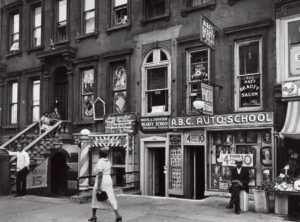Final Topic Proposal / Annotated Bibliography
- Intended topic: I wanted to study how gentrification in Harlem affected people’s lives. What do different people think about gentrification in Harlem? For example, local residents, real estate developers, and tourists. Are people willing to accept this change?
- The reason I was interested in the subject and wanted to write about it was because I thought gentrification of a place would have a big impact on the community. But there are a lot of questions to ponder, such as whether people are willing to accept this kind of change, or will it harm people’s interests?
- Background: New York City’s Harlem has always been a black community, an incubator of black culture, the birthplace of jazz, and a breeding ground for great literary talent. Gentrification refers to the reinvention of an old part of a city so that the reformed area becomes more prosperous. The gentrification of Harlem added some new life to this old community. In recent years, Harlem has developed rapidly.
- Purpose: I want to start with why Harlem is gentrified, and then explore what kind of changes gentrification will bring to people and the environment, positive and negative. After the library session on Thursday, I will use a minimum of 3 research sources to support my topic. Moreover, I’m going to summarize some of my thoughts on the effects of gentrification in Harlem.
- Source 1 (popular media source newspaper)
Williams, Timothy. “In changing Harlem, Soul Food struggles.” New York Times, May 8, 2008 http://www.nytimes.com/2008/08/06/nyregion/06soulfood.html?pagewanted=1&sq=soul%20food%20harlem&st=cse scp=1 Accessed 7 November 2020.
In the article, Timothy Williams describes the restaurant in Harlem. By showing its classic restaurants and its traditional food, people will learn more about Harlem. The author explains the impact of rezoning on these original restaurants. As the price of basic ingredients goes up, some foods will be destroyed. Timothy shows that the prices of some new restaurants are too high for some customers to afford. In this article, Timothy focuses on the Harlem rezoned, which has led to a decline in the popularity of many of the region’s classic restaurants.
Gentrification in Harlem means local restaurants lose customers. The restaurant’s owners and guests were clearly reluctant to accept the change. Rising rents and ingredients have forced businesses to raise food prices. Restaurants have also become less popular because customers can’t afford to buy food. That’s why so many traditional restaurants have gone out of business. I think gentrification in Harlem has reduced the variety of food and destroyed the traditional restaurant industry.
- Source 2 (popular media source newspaper)
Versey, H. “A Tale of Two Harlems: Gentrification, Social Capital, and Implications for Aging in Place.” Social Science & Medicine (1982), vol. 214, Elsevier BV, Oct. 2018, pp. 1–11, doi:10.1016/j.socscimed.2018.07.024. Accessed 10 November 2020.
This source is useful because Versey describes the diversity of Harlem after Gentrification, and the influence made by these diversities. Versey explains the influence of gentrified Harlem by showing some sources, such as high rents and crime rates. The article points out that most people cannot afford such high rents because of the rise in house prices caused by gentrification. As the middle class moved in, some lower-income people left Harlem, where they had lived for a long time. It led to a change in Harlem’s population.
Versey focuses on the influence after Harlem had gentrification. My argument is that gentrification in Harlem attracted a large number of middle-class arrivals that made initially a single community become diverse. That is what Business Owners and Real Estate Investors want to see because it benefits them. At the same time, the rapid rise in rents caused by gentrification became Harlem’s most serious problem. This is unacceptable to Harlem residents, most of whom are low-income. High housing prices forced them out of Harlem, where they had lived for so long. With the arrival of new residents and the departure of old ones, Harlem changed completely. Gentrification in Harlem is good for the economy, but it inevitably hurts low-income people.
- Source 3 (scholarly journal article)
Adams, Michael. “The End of Black Harlem.” The New York Times, The New York Times Company, 29 May 2016, p. 1–. https://www.nytimes.com/2016/05/29/opinion/sunday/the-end-of-black-harlem.html Accessed 8 November 2020.
In the article, Michael shows how gentrification had an important effect on Harlem’s original residents, mainly by the high housing prices. By comparing different classes, it is found that black people are not rich economically in Harlem, however, has the largest black population, and gentrification has brought new apartment buildings and other amenities that are expensive for most people, forcing them out of their long-lived community.
Michael Henry Adams focuses on the effect of gentrified Harlem housing prices on residents. In my opinion, the high rents brought by gentrification are a disaster for the low-income people in Harlem. It hurts their interests and makes them homeless. But with the gentrification of Harlem came new buildings and apartments that kept the neighborhood alive and even more prosperous. The benefits for real estate investors and the tourism industry.
- Source 4: Ebook
Zukin, Sharon. “Harlem Between Ghetto and Renaissance.” The New Blackwell Companion to the City, Wiley‐Blackwell, 2011, pp. 561–70, doi:10.1002/9781444395105.ch49.
This resource is useful because it helps readers understand the effect that Gentrification brings to Harlem. In the article, Sharon explains that Harlem will present itself in a new light, far lower than the crime rates of the past and with a wide variety of boutiques and restaurants that have enriched Harlem’s commerce and made it an upscale community. In the article, Sharon points out that gentrification brings such prosperity effects to Harlem, but it also weakens the original cultural authenticity of Harlem, and gentrification leads to the loss of the original culture of Harlem.
Sharon focused on the gentrified image of Harlem. My argument is that the reduction in crime in Harlem is something everyone in Harlem would like to change. Because the community is safer. The rich dining and luxury malls are considered profitable by real estate investors, tourism merchants, and business owners. But at the same time as gentrification, Harlem’s original traditional buildings were destroyed. No doubt artists and local residents feel regretful and difficult to accept. They did not want to see Harling lose his cultural authenticity for profit.



